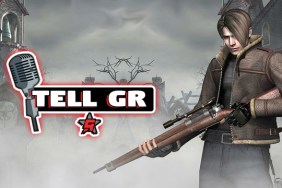The Wii’s run may be over, but it’s going out in style.
A few days ago was the 25th anniversary of Mike Tyson’s historic victory to become the youngest heavyweight champion in history. An incredible achievement, to be sure, but if you grew up in the ’90s, then you know just how far downhill it went from there. He got into trouble time after time after time until, well, he’s turned into this.
“What in Nayru’s holy name does Mike Tyson have to do with Zelda?” you may ask, and rightly so. Well, besides the fact that he also spent a brief stint making oodles of money for Nintendo, his downward spiral serves as a strong counterpoint to the beloved franchise.
If you hadn’t heard, this year is also The Legend of Zelda’s 25th anniversary as well. Nintendo’s been spending a lot of time hyping that monumental occasion up, but honestly, if all they did this year was release Skyward Sword, it would be more than a satisfying gesture to Zelda fans. Unlike Iron Mike, time has been gracious and kind to Link (even though Link has been known to screw with it once in a while).
25 years after a stout, silent elf-kid took a sword from some weird old guy in a cave, he now lifts it triumphantly skyward. And well he should, because Skyward Sword is the best Zelda game ever made. Ocarina of Time will of course always be a fan favorite, just as Twilight Princess is mine, but it’s patently obvious that in its puzzles, design, story, scope, style—all of its merits as a video game, pure and simple—this is the finest piece of work to ever have the name Zelda stamped on it.
As I made my way through this sprawling adventure, one word kept coming to mind to describe everything that I love about Skyward Sword: balance. The formula that Ocarina of Time introduced so long ago is absolutely perfect here, and it bridges the best elements of all the 3D Zeldas while getting rid of any dead weight.
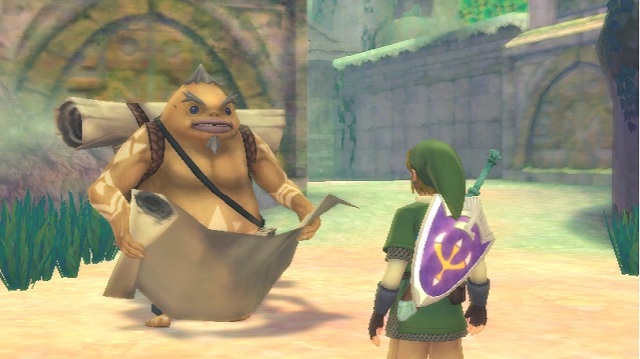
The story strikes a marvelous balance between gameplay and cinematics. As a prequel to the other titles in the series, an engaging story is key to Skyward Sword’s relevance. There are more cut-scenes than we’re used to seeing in a Zelda game, but they’re integral to the plot and they never drag on to the point where the gameplay suffers for it. This is the most engaging Zelda story ever told, and from the moment Link meets Zelda in the Skyloft plaza before his big race, everything that unfolds feels undeniably epic. That feeling is enhanced by the many allusions to the origins of important places and objects from later games in the series.
The plot is also propped up by the supporting players a lot more this time, primarily the series’ namesake herself. Link and Zelda begin as childhood friends, and instead of showing up at the beginning and end while spending the interval as a royal captive of the bad guys as usual, Zelda makes more frequent appearances and is just as important to events as our emerald-clad hero. Most of your time is, in fact, spent chasing her down while she works on her own mysterious quest, and the fleeting moments when the duo catch up with each other are touching and powerful because of the strength of their relationship.
It seems like each 3D Zelda release has been an experiment with a different art style, and Skyward Sword strikes a great balance between Wind Waker and Twilight Princess. While one was too cartoony for some and the other was too dark for others, Skyward Sword manages to merge them into something that really screams “Zelda”; it captures what, to me, A Link to the Past would be like if it were translated in 3D.

The manner of exploration is perfect—you’ll be splitting your time up between the sky and surface. Above the clouds is the main town of Skyloft, where you do your shopping and most of the sidequests. Leaving Skyloft is a simple and exhilarating matter of leaping off the edge and calling for your loftwing to swoop in and pick you up as you plummet downward.
Outside of Skyloft, you guide the loftwing to fly around to smaller floating islands and places of interest, much in the same way that you sail your boat around the sea in Wind Waker. Don’t groan just yet—despite how expansive it feels, the sky is much more condensed than the sea. It’s big enough to feel like a grand world, but small enough that it doesn’t take more than a couple minutes to fly from one end to the other, so the tedium from Wind Waker is long gone. Again—perfect balance. Flying is far more fun than sailing too, and it’s a simple joy to travel between destinations while the brilliant orchestral theme punctuates each trip.
But like any true Zelda, most of the adventure is spent on solid ground. Link’s quest takes him to important destinations beneath the clouds; in each region, the general idea is to explore a sub-section of the map until you uncover the next dungeon entrance. The work you do in these sub-sections can actually sometimes be much longer and more involved than the dungeons themselves.
Nintendo is, as usual, on top of their game in level design, with some of the most clever dungeons seen in the series. The puzzles are challenging (I even got stumped for a bit in the first dungeon), but never so much that a familiar Zelda player should get stuck for more than 15 minutes or so.
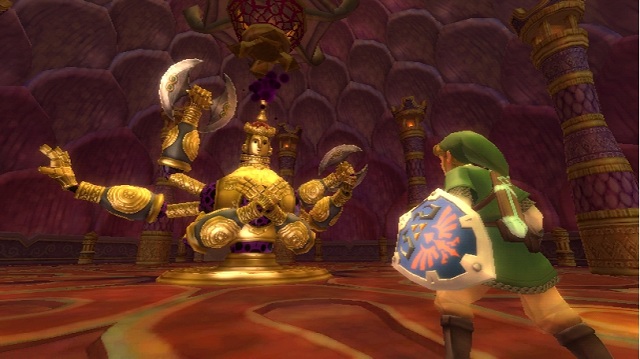
Of course, Skyward Sword’s most touted feature is the controls, and they work great for the most part. Ironically, I didn’t give much thought to the controls while I played because they’re integrated so well that it becomes second nature almost immediately. Whether it’s rolling a bomb with an upwards flick, lashing out with a whip, or of course swinging your sword with precise cuts, the item controls feel like natural movements.
The aiming for the ranged items is the only part that takes some getting used to, because the game actually calibrates the pointer each time you aim. It always assumes that the direction the Wii-mote is currently pointed is the “center”, so you need to point at the center of the TV before using the item. Hitting down on the D-pad resets the calibration on the fly in case you didn’t do that. I don’t know why the game was designed this way instead of with a one-time calibration, and there’s no actual tutorial explaining this design, so until you realize it you can run into some frustration with aiming.
Swordplay also has its occasional hiccups; while the one-to-one translation of the Wii-mote is usually spot-on, there are inevitably times when you make a hasty swing that goes diagonal instead of vertical, or try to thrust and get a sweeping slash instead.
But those moments don’t happen very often, and they’re far outweighed by just how fantastic the combat can be with the Wii MotionPlus. Earlier Zeldas required little strategy once you figured out how a certain enemy was vulnerable, but in Skyward Sword each encounter requires you to be quick and smart. Knowing how to kill an enemy isn’t enough; you have to be fast and attentive to exploit their openings when they leave that window open.
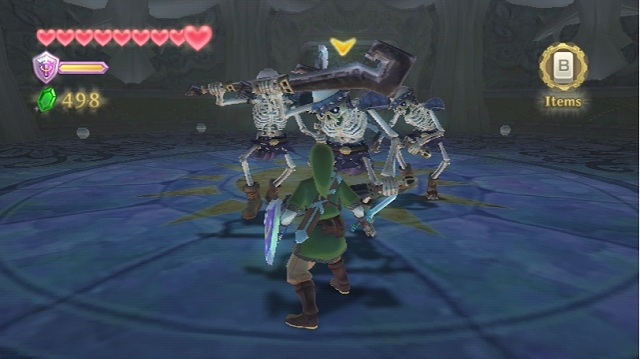
To kill a Deku Baba you need to take note of which way the mouth opens and slice along that plane. An elite Stalfos defends three sides with its sword arms and leaves one open for you to strike, but it constantly shifts the sides around. Hydras have three moving heads that need to be sliced off all at the same time, so you’ll need to swing in the right direction when they line up. Almost every enemy has inventive weak points like these that remain a challenge to exploit even once you’ve understood them.
Because of all that, combat is significantly more challenging in Skyward Sword, but also far more rewarding. I take a lot more damage in this game than I have in other Zeldas, and it’s actually not uncommon to die. But I keep coming back to that one word—balance. You may die, but when you do it’s fair and you gain that much more insight into how you can do better the next time. Eventually even the enemies that kept pummeling you before start falling to the wayside as you improve your swordplay and specific strategies against them.
That also extends to boss fights, thankfully. The distressingly easy bosses that plagued the last few Zeldas have given way to smart, challenging fights. I didn’t die to any of them, but I came very close to it quite a few times. They’re hard enough that it’s a real thrill to fight them, but not so much that you’re banging your head against the wall. When you come out the other side, it really feels like you accomplished something against a worthy foe.
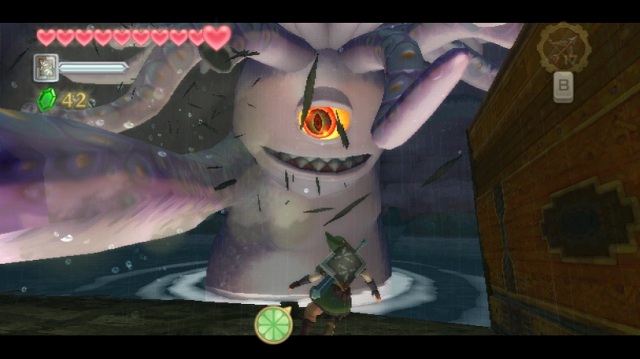
The game is also huge. There isn’t a staggering amount of terrain compared to other titles in the series, but Skyward Sword gets every last ounce of mileage out of each area. It takes a few hours just to complete each sub-section before reaching a new dungeon, followed by a few more for the dungeon itself. There’s a strong 30–40 hour adventure here before even considering the multitude of sidequests you can take on.
Like any Zelda, a beautiful score blankets the breathtaking adventure. Skyward Sword has some great orchestral arrangements, with some real standouts like the flight theme I mentioned earlier. The main theme is also fantastic, and is arguably the best one since the iconic original.
I have a few tiny quality-of-life quibbles here and there: Managing the stamina meter that governs your dashing and climbing is essential to some of the puzzles, but becomes an annoyance when you have large open ground to cover; accidentally falling off Skyloft always triggers the same repetitive cut-scene where you get rescued by a guard; you have to return to the sky each time you want to “warp” to a different save point on the ground. But these things are a tiny drop of foul water in the vast ocean of greatness that is Skyward Sword.
Last week, I gave my first ‘A’ in two years here at GR to Super Mario 3D Land. Now I’ve given my second. Somehow, Nintendo is still improving on a series that keeps setting the bar after 25 years. If you’re a Zelda fan—hell, an adventure fan in general—you need to play it. Even if you have to buy a Wii on Black Friday to do it.
Review copy not provided by publisher.
-
Best Zelda game yet
-
…and the best story, too
-
Terrific, fitting art style
-
Great balance between sky and surface exploration
-
Motion controls work great for everything
-
…once you get used to the constant calibration
-
Far deeper, tougher combat than any other Zelda
-
Great boss fights with just the right level of challenge








